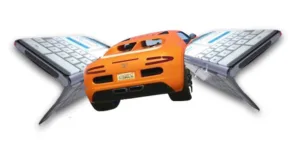Are you still waiting for the flying car you ordered in the 1960’s? Maybe it will get delivered right after you get your foldable smartphone that is supposed to have been in the market for a few years already.

As you may have heard, a Samsung engineer was reported saying that the foldable smartphone display will be ready for ‘mass consumption’ by 2019 based on an article from the Korea Herald. Of course this says that the display technology will be ready for mass consumption by then, it does not say that there will be smartphones coming out in the same year.
The hunt for the foldable display has been a long and tedious development effort to transport all those manufacturing steps developed on glass substrates onto a plastic film. In addition we add to this the issue of water sensitivities of the OLED materials resulting in a requirement for enhanced barrier properties that are a little bit more difficult to achieve than some people thought long ago.
This is another case of ‘just an engineering issue’ that ends up requiring material and process development, causing long delays for the market introduction.
Going back to the flying car issue, there was an advertisement from the NY lottery that suggested that on a Friday night, the helicopters leaving NY City were backed up for miles, while the highways were all free. This is of course after everyone became a multimillionaire from winning the lottery. Their motto is ‘Hey, you never know’.
The interesting point of this is the question “does a flying car actually makes sense?”. What would happen if everyone running into a backup on the freeway could take to the air to avoid the traffic jam? I guess the air traffic controllers would have a fit and stop it immediately. In other words, we are looking at a technical solution for a problem that can’t be solved this way anyway.
What problem is a folding smartphone solving?
The open question is “what issue is a foldable smartphone solving?” My favorite would be the ultimate smartphone / tablet conversion device. This would be the Swiss army knife of mobile computing and communication. Of course, I would like that smartphone to be thin and light when folded tight, and nice and sturdy when opened up for use as a tablet. Besides some minor mechanical engineering issues to achieve this, the display has to be as good as the typical smartphone display today (make that a pixel density of 300ppi+).
When opening up the device this result in a pixel count twice or four times (if you fold it twice) the resolution of the smartphone. Let us say we start with Quad HD (2560 x 1440) in the phone display, we end up with at least 2560 x 2880 pixels, a display resolution that doesn’t even have a name yet. Let us forget the twice folding for now anyway and assume that unfolding to create a 5120 x 1440 pixel display doesn’t make much sense either.
Such a display would have quite an odd aspect ratio that would not make sense for any mobile device. Playing a video on this display would end up in a lot of letter boxing or stretching. Not a great thing for existing content for sure.
As an alternative, we could assume that the unfolded tablet has an UHD resolution (3840 x 2560) which would mean the folded display has a resolution of 2560 x 1920 pixels or an aspect ratio of 1:1.33 or good old 4:3. It may be a good guess to assume that the foldable smartphones will not look like the ones we have today from the perspective of the aspect ratio. They will look more square to create a 16:9 display when opened.
Besides the obvious ‘engineering issues’ in creating a foldable display in the first place there is also a content issue in terms of usage for the consumer.
This is all of course only an issue if the manufacturers actually want to make a smartphone / tablet convertible. The other reason would be to make the smartphone as it is available today just smaller (at twice the thickness of course). Now that would be boring, wouldn’t it? (NH)

